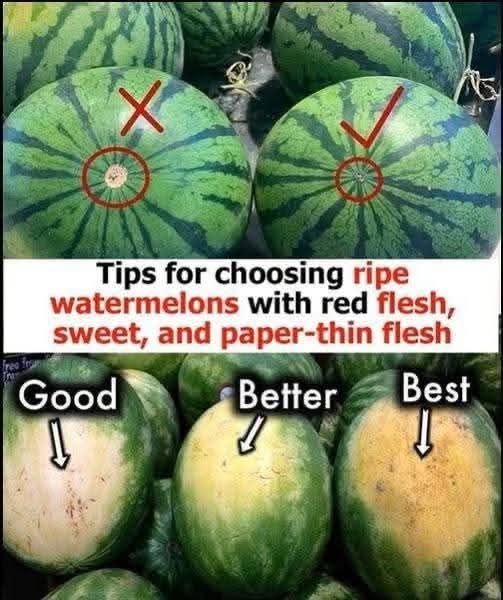How to Choose a Perfectly Ripe Watermelon – Red Flesh, Super Sweet, and Paper-Thin Rind
There’s nothing quite like biting into a juicy, red-fleshed, ultra-sweet watermelon on a hot day. But finding the perfect one—with vibrant color, rich flavor, and a thin rind—can feel like a gamble if you don’t know what to look for. Fortunately, with a few expert tips and some visual cues, you can master the art of picking a watermelon that delivers every time.
Whether you’re shopping at the grocery store, farmer’s market, or roadside stand, these proven tips for choosing ripe watermelons will help you take home a sweet, crispy, and perfectly textured fruit every time.
✅ Top Tips for Picking the Sweetest, Red-Fleshed Watermelon
🍉 1. Look for a Deep, Creamy Yellow Field Spot
The field spot is the area where the watermelon rested on the ground as it grew.
- A deep yellow or creamy golden field spot = the fruit ripened naturally on the vine.
- A white or greenish field spot means it was picked too early and may lack flavor.
👉 Pro Tip: The darker and richer the yellow spot, the sweeter the flesh.
🍉 2. Check for a Uniform Shape
Watermelons can be round or oval, but the key is symmetry.
- Uniform, balanced shape: Signals even growth and good ripening.
- Lumpy, irregular shape: May indicate poor pollination or uneven ripening.
👉 Avoid fruit with dents, large bumps, or a flat side unless you can confirm quality by other signs.
🍉 3. Knock and Listen – The Hollow Sound Test
Give the watermelon a few taps with your knuckles.
- A deep, hollow sound = ripe and full of water.
- A dull or flat sound = underripe or overripe.
👉 Think of it like tapping a drum—the more resonance, the better the texture and juiciness inside.
🍉 4. Look for Sugar Webbing and Pollination Marks
Those brown, web-like scars on the surface of the watermelon? Those are a good sign!
- Known as sugar webbing, they form when bees pollinate the flower multiple times.
- The more pollination = the sweeter the fruit.
👉 Spider-like webbing and little brown dots near the stem mean intense sweetness.
🍉 5. Inspect the Stem and Tendril (If Attached)
If your watermelon still has part of its stem or tendril, use that to your advantage:
- A dry, brown tendril near the stem means it ripened fully before being picked.
- A green tendril or stem may indicate premature harvesting.
👉 A vine-ripened melon has the best chance of being ultra-sweet with tender flesh.
🍉 6. Feel the Weight – Heavier is Better
Pick up the watermelon and compare its weight to others of similar size.
- A heavier watermelon = higher water content = more juicy and ripe.
- A lighter one may be dry, underripe, or mealy.
👉 Always go for the heaviest melon for its size.
🍉 7. Rind Texture: Dull, Not Shiny
Shiny = underripe.
Dull = ripe and ready.
- Look for a matte finish on the rind.
- A deep green color with defined striping is usually a good sign.
👉 Bonus: If the rind feels hard and resists pressure, it’s likely juicy inside.
🍉 8. Thin Rind? Look at the Ends
If you want a watermelon with a thin, paper-like rind:
- Choose melons where the white area between the skin and red flesh is minimal (you’ll only see this once cut, but some signs help).
- Generally, elongated watermelons tend to have thinner rinds than perfectly round ones.
- Some varieties, like Sugar Baby or Crimson Sweet, are known for thin rinds.
👉 If allowed to ripen fully on the vine, the rind naturally stays thinner and more tender.
🍉 9. Avoid Bruising or Soft Spots
Press gently on different parts of the rind.
- A ripe watermelon should be firm all around.
- Any soft spots, bruises, or cracks mean it may be overripe or spoiled.
👉 Consistent firmness is key to good texture and storage.
🧠 Fast Reference Chart: What to Look For in a Ripe Watermelon
| Feature | What to Look For | Why It Matters |
|---|---|---|
| Field Spot | Creamy Yellow | Indicates vine ripeness |
| Sound | Hollow, deep | Juicy and ripe interior |
| Shape | Uniform & symmetrical | Even ripening |
| Webbing | Brown web-like scars | More pollination = sweeter |
| Tendril | Dry & brown | Fully ripened |
| Weight | Heavy for size | Juicy and dense |
| Rind | Dull, firm | Fully matured |
| Skin Texture | Hard with slight give | Crisp red flesh inside |
🚫 Common Mistakes to Avoid When Choosing Watermelon
- ❌ Choosing shiny, glossy melons (they’re likely underripe)
- ❌ Ignoring the field spot
- ❌ Picking the biggest melon instead of the heaviest one
- ❌ Overlooking visible cracks or bruises
📝 Final Thoughts: Picking the Perfect Sweet Watermelon
With the right techniques, choosing a ripe watermelon with red flesh, natural sweetness, and a paper-thin rind becomes much easier. Use your eyes, ears, and hands—look for yellow field spots, listen for a hollow thump, and feel for weight and firmness.
You don’t need to be a farmer or a produce expert to pick the best watermelon—you just need a few insider tips and a keen eye.
Now you can confidently enjoy the sweetest, juiciest watermelon all season long.
